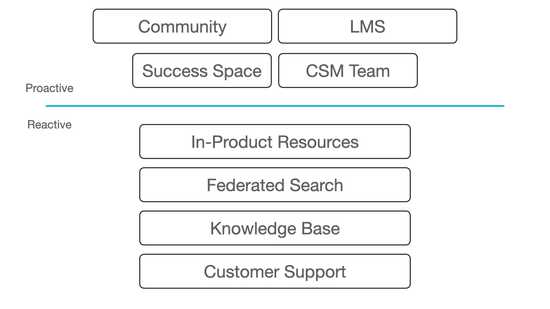Customer experience starts early and grows with a company. New employees come in, teams expand and contract, new initiatives are launched. Many moving pieces connect to create the final customer experience. Customers don't expect perfection, but it's key to create the "Wow!" moment for them.
Let's explore a thought process for designing your customer experience that reduces your stress and removes the need to get everything right on the first pass.
Thinking in Layers
There's a common practice in the software engineering world to break problems down into smaller, but complete, parts. This practice leads to more effective delivery, work allocation, and a better end result. It turns out that this practice can be applied to a lot of other problems, like designing a customer experience.
Break apart each initiative involved in your customer experience to see what can stand on its own, what is connected, and how information flows across the experience. Here's an example of a customer flow broken up this way:
Some layers are non-negotiable—every company needs a way to address customer problems. But other layers are optional. They could be tackled right now, or in the future. Don't stress about getting everything right the first time. Depending on your particular stage, you may have significantly more layers as the complexity of your customer base increases.
Take tally of the initiatives you are doing now or you'd like to do. Keep track of what the goal of the initiative is. With your given resources, is that something that can wait or is it an immediate concern?
Proactive Versus Reactive
There's a line going across the layers above, this is the proactive-vs-reactive line. Layers below this line are seen by a customer in response to a problem. Maybe they ran into something they don't understand, the app is not working correctly for them, or they're a churn risk.
Layers in the proactive area can be broad and strategic. Your Learning Management System content is focused on general usage of your product. Your CSM content is focused on strategic initiatives and value-add.
Layers in the reactive area should be focused on a single problem. Your customers have a need that must be addressed. For example, broad support responses will not be effective here because the customer needs a single thing solved. Broad education needs to happen afterwards, in a focused activity.
Some initiatives are going to be effective only proactively, and others are only going to work reactively. It would not be very worthwhile to reach out to support if there's not a problem. Likewise, customers are probably not going into a Learning Management System to lookup information on a specific problem they ran into.
Make Your Layers Flow
The flow of information through your CX layers is just as important as the initiatives themselves. This is how a good experience becomes a great one.
Each layer contributes to an initiative or goal. These might be owned by different people or departments, but the end goal is the same. The impact of one layer can affect the impact of another, if they work in harmony.
In the previous example, the different layers have an opportunity to flow into each other to create a more seamless experience. The LMS content can cross-reference knowledge base articles to ensure it's always up to date. The in-app experience pulls together resources from the other initiatives to create an "in the moment" experience. All of this contributes to an end-goal of reducing the need to go to support.
A consistent presentation and curation of content leads to a feeling of a put-together experience. Knowledge by your team of the various layers and what is available to achieve a particular customer's needs gives a feeling of expertise. Accurate and relevant resources presents a feeling of trust.
Change Will Happen
If there's one thing that you can count on, it's change. Have you ever put a ton of work into a project just to have some key aspect change on you at the last minute? It's rough.
You should not try to predict change, because you can't. Instead, design your experience to easily accommodate change as needed. Launching a new initiative should be as easy as possible, and consistent with your larger experience design. Removing a low-performing initiative should also be an easy task.
Generally speaking, many layers can stand on their own. This means its possible to swap technology without too much impact on the larger whole. However, it requires a bit of intentional thought and acknowledgement that change will happen. Enforce consistent brand guidelines, login technology (application SSO is ideal), and goals throughout your experience.
How can Clove help?
Clove supports your experience initiatives without requiring specific technology choices. We bring together the technology you are using (Zendesk, Salesforce, Intercom, many more) into one experience for the customer.
We work with your existing technology, but some features stand on their own in your customer experience:
- Success Spaces give your CSMs a place to perfectly distribute content for their customers
- Our drop-in widget allows you to quickly embed your resources in your application
- Page-specific resources helps guide users to content that is relevant to the page they're on
- Integrated analytics tell you how users consume your content, on a per-user or per-account level
We make it easier to launch new initiatives. Our SSO feature can integrate with your customer experience tools to remove the need to go back to product for every new initiative. Clove customer hubs are completely customizable to match your brand guidelines.
Think of Clove as your superpower in achieving your ideal customer experience.
